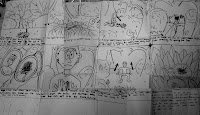 this is the scarf and gloves that luke will be wearing
this is the scarf and gloves that luke will be wearing  This is the jacket that Luke will be wearing
This is the jacket that Luke will be wearing 
 this is the scarf and gloves that luke will be wearing
this is the scarf and gloves that luke will be wearing  This is the jacket that Luke will be wearing
This is the jacket that Luke will be wearing 


I looked into the conventions of the thriller genre so I have a background knowledge of what I am trying to create, this is help me out greatly as i know what devices to use to get the right effects.
The term crabbing shot is a less-common version of tracking, trucking and/or dollying. These terms are more or less interchangeable, although dollying tends to mean in-and-out movement whereas the others tend to mean side-to-side movement at a constant distance from the action.
A pan is a horizontal camera movement in which the camera moves left and right about a central axis. This is a swiveling movement, i.e. mounted in a fixed location on a tripod or shoulder, rather than a dolly-like movement in which the entire mounting system moves.
Sound whose source is visible on the screen or whose source is implied to be present by the action of the film:
There are three possible ways to present time in a video or film sequence:
We decided to carry out a questionnaire to see what the audience likes and what they dislike, so we can see specifically what we should be focusing on. The reasoning behind the question of gender is so that we can see if there is any differences or patterns between male and female. We asked what age they are so when we decide on an age rating we can see what that age specifically wants to see in a movie. We wanted to know what sub-genres the audience like the most so that we can base our desicion on this. The rest of the questions are there so that we can get a genreal knowledge of what the audience wants to see so that we can give it to them.
Are you male or female?
Male □ Female □
Tick the age category that you fit in to –
15 – 17 □ 18 – 25 □ 26 – 35 □ 36 - 45 □ 46 – 55 □ 55+ □
do you prefer 15+ or 18+ thriller films usually, if you are under 18 you may still vote for 18+
15+ □
18+ □
What type of sub genre within thrillers do you enjoy? Tick as many as apply
Action- thriller □
Western-thriller □
Crime-thriller □
Film noir – thriller □
Religious thriller – such as Da Vinci code □
Gangster thriller □
Psychological thriller □
Please tick the thriller films that you have really enjoyed from the list below – as many as apply
Jaws □
Paranormal activity □
The godfather □
Inception □
Pulp fiction □
The Dark Knight □
Psycho □
Se7en □
Die hard □
Memento □
Silence of the lambs □
What do you feel is very important in a thriller film? Rank from one to eight with one being least important and eight being most
A feeling of suspense □
Fast paced music □
A plot twist □
Action □
Gore □
Science □
A sense of reality – not too farfetched □
A clever storyline □
Do you like to see credits in the opening of the film?
Yes □
No □
Don’t mind □






We think these pictures are valuable and gave us a clearler idea of what we need to film but after this we decided that it would be more benificial if we did the story board again but with more pictures so it is alot clearer and we know pretty much what the end product will look like. http://www.flickr.com/photos/56734761@N04/sets/72157625418080173/ Unfortunatly i could not upload them straight to the blog because there are too many images (64 I think) so i uploaded them to flickr. The only problem with this is that the images are not in order.